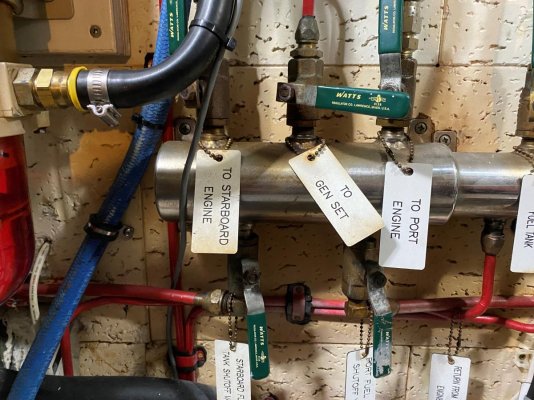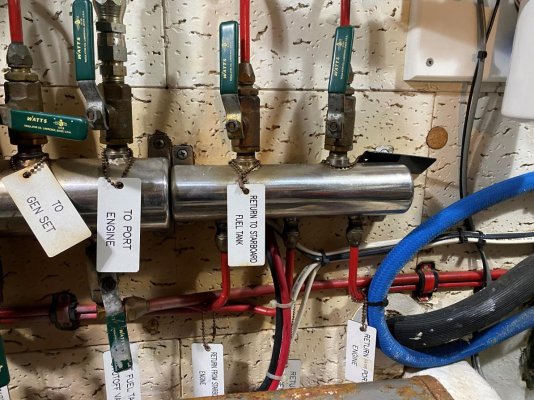Msamsen
Veteran Member
- Joined
- Jul 21, 2021
- Messages
- 39
- Vessel Name
- MeriMae
- Vessel Make
- Ocean Alexander/ Ocean 43
in 22 years of boating and boat maintenance, I finally have a stumper, so going to throw it out to you all!
On our shake down cruise a month ago, we anchored after 3 uneventful hours of cruising @1250 rpms on our OA 43 w/ twin DD 453s. That evening our Northern Lites 5KW genset wouldn't start. Just cranking and cranking. OK no problem, I'll have a look at it when we get back. The next morning we take off for home and after about 20 mins. of 900 rpm courtesy cruising, the starboard engine starts bogging so I shut her down, and then the port followed up doing the same. (On a side note, my fuel flow meter has been showing erratic readings on the port side, like 54 GPH).
Back at our home port after a long tow, I started going through the fuel system. I changed both the Racors and secondaries, again, after the spring maintenance. Removed the port tank inlet line on the supply manifold (pictured) and ran fuel through it from the starboard tank using a small auto store fuel pump into a glass bottle to see if there was any blocking type material from the tanks. Nada. Primed the system then they both started right up. I haven't taken her out for a sea trial, since i haven't found the smoking gun yet and am a bit hesitant to be under tow again. So my working theory is this:
With both tanks at 1/4 full ( dipstick confirmed) the engine supply impeller pumps are not strong enough to pull the fuel out of the top mounted siphon tubes and I need to change them both (seems odd that both stopped working effectively at once), but that still doesn't account for the Genset not starting, which I haven't gotten to yet and may be just coincidence (I cracked a rib on vacation and am reduced to keyboard troubleshooting, hence the lengthy post) Another theory is that the return manifold (pictured) is clogged and not allowing fuel to circulate properly, causing them to bog down.
I am also getting ready to install an electric lift pump on each side to delivery 2-3 lbs of fuel pressure from the tanks (which I can also use for tank transfers). Good idea?
Any and all ideas/ suggestions are much appreciated!
Thanks and happy sailing!
Marc
On our shake down cruise a month ago, we anchored after 3 uneventful hours of cruising @1250 rpms on our OA 43 w/ twin DD 453s. That evening our Northern Lites 5KW genset wouldn't start. Just cranking and cranking. OK no problem, I'll have a look at it when we get back. The next morning we take off for home and after about 20 mins. of 900 rpm courtesy cruising, the starboard engine starts bogging so I shut her down, and then the port followed up doing the same. (On a side note, my fuel flow meter has been showing erratic readings on the port side, like 54 GPH).
Back at our home port after a long tow, I started going through the fuel system. I changed both the Racors and secondaries, again, after the spring maintenance. Removed the port tank inlet line on the supply manifold (pictured) and ran fuel through it from the starboard tank using a small auto store fuel pump into a glass bottle to see if there was any blocking type material from the tanks. Nada. Primed the system then they both started right up. I haven't taken her out for a sea trial, since i haven't found the smoking gun yet and am a bit hesitant to be under tow again. So my working theory is this:
With both tanks at 1/4 full ( dipstick confirmed) the engine supply impeller pumps are not strong enough to pull the fuel out of the top mounted siphon tubes and I need to change them both (seems odd that both stopped working effectively at once), but that still doesn't account for the Genset not starting, which I haven't gotten to yet and may be just coincidence (I cracked a rib on vacation and am reduced to keyboard troubleshooting, hence the lengthy post) Another theory is that the return manifold (pictured) is clogged and not allowing fuel to circulate properly, causing them to bog down.
I am also getting ready to install an electric lift pump on each side to delivery 2-3 lbs of fuel pressure from the tanks (which I can also use for tank transfers). Good idea?
Any and all ideas/ suggestions are much appreciated!
Thanks and happy sailing!
Marc


